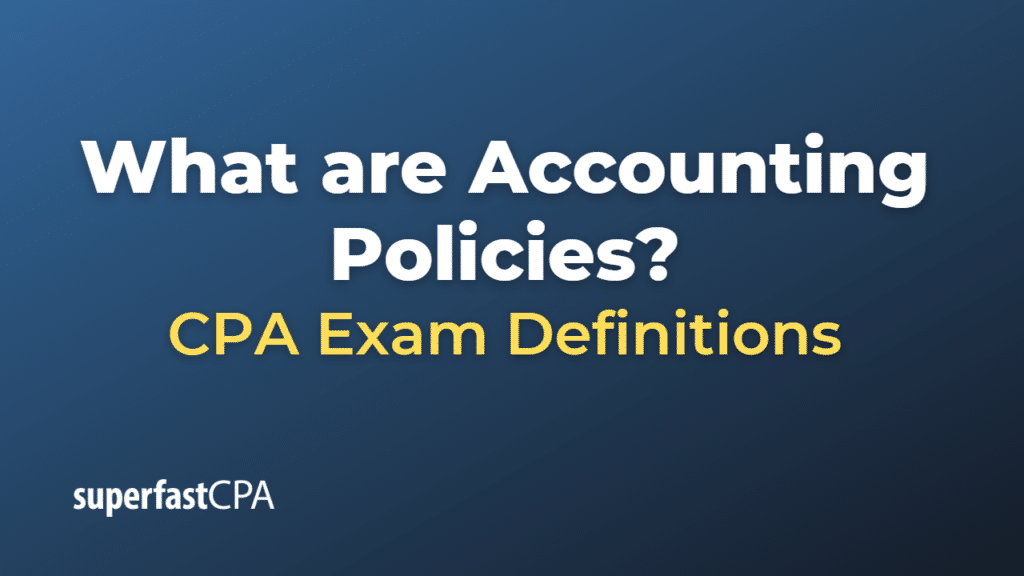Accounting Policies
Accounting policies are the specific principles, rules, and procedures that a company adopts to prepare and present its financial statements. These policies provide a framework for consistently and systematically recording, measuring, and reporting financial transactions. Accounting policies are an essential component of a company’s overall financial reporting system and help ensure that its financial statements are comparable, consistent, and reliable.
Accounting policies are typically based on established accounting standards, such as Generally Accepted Accounting Principles (GAAP) in the United States or International Financial Reporting Standards (IFRS) in many other countries. However, companies often have some flexibility in choosing specific accounting policies within the framework of these standards, based on their industry, size, and the nature of their operations.
Some common areas where companies may adopt specific accounting policies include:
- Revenue recognition: Companies must determine when to recognize revenue from the sale of goods or services, based on the specific criteria and methods prescribed by accounting standards. Accounting policies in this area may include the percentage-of-completion method, the completed-contract method, or the point-of-sale method, depending on the nature of the business and its transactions.
- Inventory valuation: Companies must choose a method for valuing their inventory, which can significantly impact their reported cost of goods sold, gross profit, and net income. Common inventory valuation methods include First-In, First-Out (FIFO), Last-In, First-Out (LIFO), and the weighted average cost method.
- Depreciation and amortization: Companies must determine a method for allocating the cost of long-lived assets, such as property, plant, and equipment, or intangible assets, over their useful lives. Common depreciation and amortization methods include straight-line, declining balance, and units of production.
- Leases: Companies must choose an accounting policy for recognizing and reporting leases, either as operating leases or finance leases, based on the specific criteria and requirements of the applicable accounting standards.
- Impairment of assets: Companies must establish policies for testing and measuring the impairment of assets, such as goodwill, intangible assets, and long-lived assets, to ensure that their carrying values in the financial statements are not overstated.
It is essential for companies to clearly disclose their accounting policies in the notes to their financial statements, as these policies can have a significant impact on the financial results and position reported in the statements. Companies must consistently apply their chosen accounting policies and make any changes in a transparent and timely manner, in accordance with the requirements of the applicable accounting standards.
Example of Accounting Policies
Let’s consider a hypothetical example involving two companies, “BikeWorld” and “CycleNation,” both of which manufacture and sell bicycles. These companies have adopted different accounting policies for inventory valuation and depreciation, which can impact their financial statements.
- Inventory Valuation:
BikeWorld uses the First-In, First-Out (FIFO) method for inventory valuation, while CycleNation uses the Last-In, First-Out (LIFO) method.
Assume that both companies started the year with 100 bicycles in inventory, valued at $200 each. During the year, they both purchased an additional 100 bicycles at $250 each. They each sold 150 bicycles during the year.
Using FIFO, BikeWorld’s cost of goods sold (COGS) would be calculated as follows:
- 100 bicycles (from the beginning inventory) x $200 = $20,000
- 50 bicycles (from the new purchases) x $250 = $12,500
- COGS = $20,000 + $12,500 = $32,500
Using LIFO, CycleNation’s COGS would be calculated as follows:
- 100 bicycles (from the new purchases) x $250 = $25,000
- 50 bicycles (from the beginning inventory) x $200 = $10,000
- COGS = $25,000 + $10,000 = $35,000
In this example, the different inventory valuation methods result in different COGS and gross profit amounts, which could impact the companies’ reported net income and financial performance.
- Depreciation:
BikeWorld uses the straight-line depreciation method for its property, plant, and equipment (PP&E), while CycleNation uses the declining balance method.
Assume that both companies purchased a piece of equipment for $100,000 with an estimated useful life of 10 years and no residual value.
Using the straight-line method, BikeWorld’s annual depreciation expense would be calculated as follows:
- ($100,000 – $0) / 10 years = $10,000 per year
Using the declining balance method (assuming a double-declining rate), CycleNation’s depreciation expense would be calculated as follows:
- 2 x (1/10) x $100,000 = $20,000 for the first year
- 2 x (1/10) x ($100,000 – $20,000) = $16,000 for the second year, and so on.
In this example, the different depreciation methods result in different depreciation expenses and net book values of the equipment, which could impact the companies’ reported net income, total assets, and financial position.
These examples demonstrate how the choice of accounting policies can significantly affect the financial statements and comparability of different companies, emphasizing the importance of transparent disclosure and consistent application of accounting policies in financial reporting.












